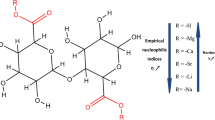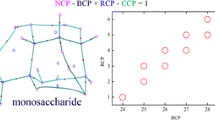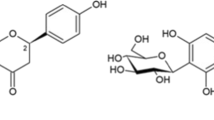Abstract
Rare sugars are monosaccharides with tremendous potential for applications in pharmaceutical, cosmetics, nutraceutical, and flavors industries. The four rare sugars, including gulose, allose, altrose, and talose, are stereoisomers that are different in the hydroxyl group orientation (axial or equatorial) on the C2-4 atoms. The basis sets effect in evaluation of the possibility intramolecular hydrogen bonding (H-bonds) in the selected rare sugars was studied from 6-31G* to 6–311 ++ G(d,p) basis sets using DFT, AIM, and NBO methods. The results show that the selected rare sugars are more stable at 6–311 ++ G(d,p) basis sets compared to 6-31G* because their electronic energies were reduced between 158 and 164 (kcal.mol−1). The overall effect of basis set enhancement is to decrease H-bond energies in the range of 1.25 to 2.51 (kcal.mol−1) and stabilization energies between 2 and 5 (kcal.mol−1) in the selected rare sugars at the DFT level of theory. The intramolecular H-bond distances, H-bond energies obtained from the AIM analysis, and also the second-order stabilization energies obtained from the NBO analysis were fluctuated largely depending on the basis set. In summary, it was found that the use of 6–311 ++ G(d,p) basis set to be more efficient results in rare sugars geometry than the 6-31G* basis set.
Graphical abstract







Similar content being viewed by others
Data availability
The datasets generated and/or analyzed during the current study are available from the corresponding author on reasonable request.
Code availability
Spartan 14 –Gaussian 09.
References
Mu W et al (2012) Recent advances on applications and biotechnological production of D-psicose. Appl Microbiol Biotechnol 94:1461–1467
Hoshikawa H et al (2011) Enhancement of the radiation effects by D-allose in head and neck cancer cells. Cancer Lett 306:60–66
Granström TB, Izumori K, Leisola M (2007) A rare sugar xylitol. Part II: biotechnological production and future applications of xylitol. Appl Microbiol Biotechnol 74(2):273–276. https://doi.org/10.1007/s00253-006-0760-4
Levin GV et al (1995) Sugar substitutes: their energy values, bulk characteristics, and potential health benefits. Am J Clin Nutr 62:1161S-1168S
Tang S-Y (2012) Rare sugars: applications and enzymatic production. J Biocatal Biotransform 1:2. https://doi.org/10.4172/2324-9099.1000e105
Robyt J (1998) Essentials of carbohydrate chemistry. Springer, Berlin
Kajikawa T et al (2010) Reactivity of rare sugar D-allose during glycation of human serum albumin. J Anal Bio-Sci 33(3)227–236
Sazalee SA, Ahmad N, Hashim R (2017) Investigation of self-assembly properties and the effect of tween series co-surfactants on the stability of nonionic branched-chain glycolipid hexosomes. Colloid Surf A 529:210–221
Panico R, Powell W, Richer J (1993) A guide to IUPAC nomenclature of organic compounds: recommendations 1993. International Union of Pure Applied Chemistry Commission on the Nomenclature of Organic Chemistry. Blackwell Scientific, Oxford
Lomas JS (2018) Intramolecular O-H⋯O and C-H⋯O hydrogen bond cooperativity in D-glucopyranose and D-galactopyranose—A DFT/GIAO, QTAIM/IQA, and NCI approach. Mag Reson Chem 56(8):748–766
Hermansson M, von Heijne G (2003) Inter-helical hydrogen bond formation during membrane protein integration into the ER membrane. J Mol Bio 334(4):803–809
Arneson LS et al (2001) Hydrogen bond integrity between MHC class II molecules and bound peptide determines the intracellular fate of MHC class II molecules. J Immunol 167(12):6939–6946
Lipinski CA et al (2001) Experimental and computational approaches to estimate solubility and permeability in drug discovery and development settings1PII of original article: S0169-409X(96)00423-1. The article was originally published in Adv Drug Deliver Rev 23 (1997) 3–25.1. Ad Drug Deliv Rev 46(1):3–26
Jeffrey GA, Saenger W (1994) Hydrogen Bonding in Biological Structures. Springer-Verlag, Heidelberg
Jeffrey GA, Saenger W (1991) Hydrogen bonding in biology and chemistry. Springer-Verlag, Berlin
Emsley J (1980) Very strong hydrogen bonding. Chem Soc Rev 9(1):91–124
Claesson PM et al (2006) Short-range interactions between non-ionic surfactant layers. Phys Chem Chem Phys 8(47):5501–5514
Larson J, McMahon T (1984) Gas-phase bihalide and pseudobihalide ions. An ion cyclotron resonance determination of hydrogen bond energies in XHY-species (X, Y= F, Cl, Br, CN). Inorg Chem 23(14):2029–2033
MosapourKotena Z, Behjatmanesh–Ardakani R, Hashim R (2014) AIM and NBO analyses on hydrogen bonds formation in sugar-based surfactants (α/β-d-mannose and n-octyl-α/β-d-mannopyranoside): a density functional theory study. Liq Cryst 41(6):784–792
Kotena ZM, Mohamad SB (2017) Bifurcated hydrogen bond in rare sugar by computational study. Mol Cryst Liq Cryst 646(1):31–40
Kotena ZM, Fattahi A (2020) Influence of H‐bonds on acidity of deoxy‐hexose sugars. J Phys Org Chem 33(10)1–17
Kotena ZM, Fattahi A (2020) Comparison of acidity and metal ion affinity of D-Glucosamine and N-acetyl-D-glucosamine, a DFT study. J Mol Graph Model 98:107612
Lomas JS, Joubert L (2017) On the importance of intramolecular hydrogen bond cooperativity in d-glucose – an NMR and QTAIM approach. Mag Reson Chem 55(10):893–901
Berezin KV, Nechaev VV (2004) Comparison of theoretical methods and basis sets for ab initio and DFT calculations of the structure and frequencies of normal vibrations of polyatomic molecules. J Appl Spectrosc 71:164–172
Del Bene JE (1987) Basis set and correlation effects on computed positive ion hydrogen bond energies of the complexes A H , A H , + 1 + 1...AH, = N H 3 , OHz, and F H. J Comput Chem 8(6):810–815
Bader RF (1991) A quantum theory of molecular structure and its applications. Chem Rev 91(5):893–928
Espinosa E et al (1999) Topological analysis of the electron density in hydrogen bonds. Acta Crystalloger B 55(4):563–572
Weinhold F (1997) Nature of H-bonding in clusters, liquids, and enzymes: an ab initio, natural bond orbital perspective. J Mol Struct 398:181–197
Reed AE, Curtiss LA, Weinhold F (1988) Intermolecular interactions from a natural bond orbital, donor-acceptor viewpoint. Chem Rev 88(6):899–926
Spartan ‘14' (2014) Wavefunction, Inc., Irvine, CA. V1.1.4 26
Contreras CS et al (2012) On the path to glycan conformer identification: gas-phase study of the anomers of methyl glycosides of N-Acetyl-d-glucosamine and N-acetyl-d-galactosamine. Int J Mass Spectrom 330–332:285–294
Frisch MJ, Trucks GWT. Schlegel HB et al (2009) Gaussian 09 ,Revision A. 02. Wallingford CT
Appell M, Willett JL, Momany FA (2005) DFT study of α- and β-d-mannopyranose at the B3LYP/6-311++G** level. Carbohyd Res 340(3):459–468
Momany FA et al (2005) B3LYP/6-311++G** geometry-optimization study of pentahydrates of α- and β-d-glucopyranose. Carbohyd Res 340(9):1638–1655
Momany FA et al (2006) DFT study of α- and β-d-galactopyranose at the B3LYP/6-311++G** level of theory. Carbohyd Res 341(4):525–537
Popelier PL, Hall P (2000) Atoms in molecules: an introduction. Prentice Hall, Hoboken
Bader R (1995) Atoms in molecules. A quantum theory. Oxford University Press, Oxford
Biegler-König F et al (2002) AIM2000. University of Applied Sciences, Bielefeld
Glendening EM, Reed A, Carpenter J, Winhold F, (2003)NBO 3. 1
Mosapour Kotena Z et al (2013) Hydrogen bonds in galactopyranoside and glycopyranoside: a density functional theory. J Mol Model 19(2):589–599
Kawahara S-I, Uchimaru T (2000) Basis set effect on hydrogen bond stabilization energy estimation of the Watson-Crick type nucleic acid base pairs using medium-size basis sets: single point MP2 evaluations at the HF optimized structures. Phys Chem Chem Phys 2(13):2869–2872
Zaharim WN et al (2020) Basis set effects in density functional theory calculation of muoniated cytosine nucleobase. Key Eng Mater 860:282–287
Popelier P (1998) Characterization of a dihydrogen bond on the basis of the electron density. J Phys Chem A 102(10):1873–1878
Espinosa E, Molins E, Lecomte C (1998) Hydrogen bond strengths revealed by topological analyses of experimentally observed electron densities. Chem Phys Lett 285(3–4):170–173
Popelier P, Bader R (1992) The existence of an intramolecular C- H... O hydrogen bond in creatine and carbamoyl sarcosine. Chem Phys Lett 189(6):542–548
Del Bene JE (1987) Basis set and correlation effects on computed positive ion hydrogen bond energies of the complexes AHn · AHn + 1+1: AHn = NH3, OH2, and FH. J Comput Chem 8(6):810–815
Momany FA, Willett JL (2000) Computational studies on carbohydrates: I. Density functional ab initio geometry optimization on maltose conformations. J Comput Chem 21(13):1204–1219
Strati GL, Willett JL, Momany FA (2002) Ab initio computational study of beta-cellobiose conformers using B3LYP/6-311++G**. Carbohyd res 337(20):1833–1849
Author information
Authors and Affiliations
Contributions
All authors contributed to the study conception and design. Material preparation, data collection, and analysis were performed by Zahrabatoul Mosapour Kotena, Mozhan Razi, and Sara Ahmadi. The first draft of the manuscript was written by Zahrabatoul Mosapour Kotena, and all authors commented on previous versions of the manuscript. All authors read and approved the final manuscript.
Corresponding author
Ethics declarations
Conflict of interest
The authors declare no competing interests.
Additional information
Publisher's note
Springer Nature remains neutral with regard to jurisdictional claims in published maps and institutional affiliations.
Rights and permissions
About this article
Cite this article
Mosapour Kotena, Z., Razi, M. & Ahmadi, S. Evaluation of hydrogen bonds formation in the selected rare sugars based on 6-31G* and 6–311 + + G(d,p) basis sets. J Mol Model 27, 315 (2021). https://doi.org/10.1007/s00894-021-04916-9
Received:
Accepted:
Published:
DOI: https://doi.org/10.1007/s00894-021-04916-9




